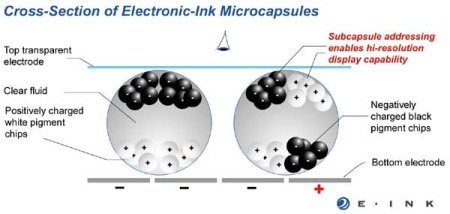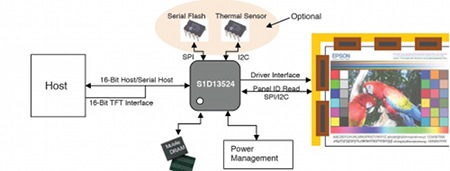E Ink touts e-readers with color, capacitive touch
Aug 11, 2010 — by LinuxDevices Staff — from the LinuxDevices Archive — 5 viewsE Ink is now sampling two new touch-enabled displays for e-readers, one offering a capacitive digitizer and using electromagnetic technology, DigiTimes reports. Meanwhile, a color E Ink display is shipping and will be offered in a Hanvon device in the fourth quarter, the publication adds.
 Electrophorescent (EPD) displays sourced from E Ink have been used in the majority of e-readers to date. Examples include Amazon's market-leading, Linux-based Kindle — recently updated to become smaller and lighter (see image at right).
Electrophorescent (EPD) displays sourced from E Ink have been used in the majority of e-readers to date. Examples include Amazon's market-leading, Linux-based Kindle — recently updated to become smaller and lighter (see image at right).
EPD displays offer a relatively bright, high-contrast, thin, lightweight display technology that remains legible under "any lighting condition" — much like newsprint. Once an image has been "printed," no power is needed to hold it, reducing energy requirements by 99 percent compared to LCDs, E Ink claims.

E Ink's electronic paper requires no power to hold images
Source: E Ink Corporation
Not all E Ink displays have offered touch, however, and up to this point, none has delivered color.
Now, DigiTimes writers Susie Pan and Yvonne Yu quote E Ink chairman Scott Liu as saying the company recently launched two new touchscreen EPDs, one of them a capacitive solution and the other featuring an electromagnetic digitizer. The first of these would allow finger operation, like Apple's popular iPad, while the second would require a dedicated pen, appropriate for note-taking and the like.

E Ink's chairman Scott Liu with Hanvon's upcoming color e-reader
Source: DigiTimes
As for color, Digitimes quotes Liu (above) as saying a color EPD is in production and will be incorporated in a Hanvon e-reader in the fourth quarter. The color panel is said to combine color filters with E Ink's latest Pearl technology, and to offer improved response time and reflectivity.
Pearl, announced at the beginning of July, is claimed to take E Ink displays from a contrast ratio typical of newspapers to a higher ratio that's typical of paperback books. Touted as offering "the whitest reflective displays in the industry," the upgrade made its debut in an improved version of Amazon's 9.7-inch Kindle DX, and may now also be found in the third-generation, six-inch Kindle mentioned earlier in this story.
Meanwhile, the existence of color EPDs and a Hanvon device using them was already tipped by Epson, which announced a relevant controller chip, the S1D13524, at the end of last month. The chip, a block diagram of which is shown below, is said to support monochrome E Ink displays up to 3200 x 2560 pixels and color displays up to 2560 x 2048 pixels.

A block diagram of the Epson S1D13524
(Click to enlarge)
Demand for EPD displays is surging, and E Ink expects color e-readers to account for 10 percent of the global market in 2011, Liu reportedly told DigiTimes. The company recently posted a 2Q 2010 operating profit of NT $1.34 billion (about $35.6 million U.S.), up 80 percent sequentially, but margins are expected to fall as clients drop the prices of their products, DigiTimes adds.
 Meanwhile, falling prices have led to the cancellation of one promising, WE Ink- and Windows CE-based e-reader, the Plastic Logic Que proReader (left). This flexible, 8.5 by 11-inch device was first announced in April 2009, but was
Meanwhile, falling prices have led to the cancellation of one promising, WE Ink- and Windows CE-based e-reader, the Plastic Logic Que proReader (left). This flexible, 8.5 by 11-inch device was first announced in April 2009, but was
Originally based in Massachusetts, E Ink Corporation was acquired last year by Taiwanese display manufacturer Prime View International (PVI), also known as Yuan Tai Technologies, for about $450 million. In June, PVI announced it was changing the international version of its name from PVI to E Ink Holdings, "reaffirming its strong commitment to e-paper."
Further information
The Digitimes article referenced earlier in this story may be found here.
This article was originally published on LinuxDevices.com and has been donated to the open source community by QuinStreet Inc. Please visit LinuxToday.com for up-to-date news and articles about Linux and open source.